Geology, Geochemistry, and Geochronology of Gabbro from the Haoyaoerhudong Gold Deposit, Northern Margin of the North China Craton
Abstract
:1. Introduction
2. Geological Setting
3. Samples and Analytical Methods
3.1. Whole-Rock Major and Trace Elements
3.2. Zircon U–Pb Dating
3.3. Sr–Nd Isotope
4. Results
4.1. SHRIMP U–Pb Age
4.2. Major and Trace Element Data
4.3. Sr–Nd Isotopic Data
5. Discussion
5.1. Timing of a Hercynian Mafic Magmatic Event
5.2. Magma Source and Petrogenesis
5.3. Implications for the Tectonic Setting
6. Conclusions
Author Contributions
Funding
Acknowledgments
Conflicts of Interest
Appendix A
| Spot | U | Th | U/Th | Pb* | Pbc | 206Pb/238U | ±% | 207Pb/235U | ±% | 207Pb/206Pb | ±% | 206Pb/238Uage (Ma) | ±% |
|---|---|---|---|---|---|---|---|---|---|---|---|---|---|
| RB25-1 | 188 | 203 | 1.11 | 7.03 | -- | 0.04353 | 1.3 | 0.313 | 3.3 | 0.0585 | 2.6 | 274.7 | 3.4 |
| RB25-2 | 257 | 293 | 1.17 | 9.84 | 0.61 | 0.04421 | 1.2 | 0.297 | 4.7 | 0.0538 | 3.8 | 278.9 | 3.2 |
| RB25-3 | 214 | 200 | 0.97 | 8.04 | -- | 0.04390 | 1.2 | 0.342 | 4.0 | 0.0548 | 3.7 | 277.0 | 3.3 |
| RB25-4 | 405 | 521 | 1.33 | 15.5 | 0.49 | 0.04438 | 1.1 | 0.315 | 5.2 | 0.0574 | 2.8 | 279.9 | 3 |
| RB25-5 | 306 | 331 | 1.12 | 11.6 | 0.16 | 0.04403 | 1.2 | 0.330 | 4.6 | 0.0571 | 2.3 | 277.7 | 3.2 |
| RB25-6 | 186 | 212 | 1.18 | 6.80 | 0.29 | 0.04242 | 1.3 | 0.300 | 5.4 | 0.0532 | 3.0 | 267.8 | 3.4 |
| RB25-9 | 378 | 471 | 1.29 | 14.6 | -- | 0.04514 | 1.1 | 0.3193 | 2.6 | 0.0553 | 2.0 | 284.6 | 3 |
| RB25-10 | 285 | 368 | 1.33 | 10.9 | 0.54 | 0.04432 | 1.2 | 0.337 | 6.4 | 0.0631 | 3.8 | 279.6 | 3.2 |
| RB25-11 | 328 | 349 | 1.10 | 12.8 | 0.19 | 0.04532 | 1.1 | 0.326 | 3.9 | 0.0556 | 2.1 | 285.8 | 3.1 |
| RB25-13 | 259 | 275 | 1.10 | 9.69 | 0.15 | 0.04355 | 1.2 | 0.321 | 4.4 | 0.0541 | 2.6 | 274.8 | 3.2 |
| RB25-14 | 343 | 350 | 1.05 | 13.1 | 0.56 | 0.04416 | 1.1 | 0.318 | 5.3 | 0.0597 | 2.0 | 278.5 | 3.1 |
| RB25-15 | 324 | 388 | 1.24 | 12.5 | 0.05 | 0.04495 | 1.1 | 0.322 | 3.9 | 0.0572 | 2.6 | 283.4 | 3.1 |
| RB25-17 | 380 | 436 | 1.18 | 14.5 | 0.29 | 0.04432 | 1.1 | 0.302 | 3.8 | 0.0542 | 2.0 | 279.6 | 3 |
| RB25-18 | 191 | 215 | 1.16 | 7.23 | -- | 0.04409 | 1.2 | 0.312 | 3.3 | 0.0506 | 3.0 | 278.1 | 3.4 |
| RB25-19 | 207 | 239 | 1.20 | 7.95 | 0.59 | 0.04456 | 1.2 | 0.298 | 5.1 | 0.0581 | 2.6 | 281.0 | 3.4 |
| RB25-20 | 272 | 290 | 1.10 | 10.3 | 0.32 | 0.04391 | 1.2 | 0.298 | 5.8 | 0.0512 | 2.5 | 277.0 | 3.2 |
| Sample | RB4 | RB5 | RB7 | RB8 | RB9 | RB10 | RB20 | RB22 | RB23 | RB25 |
|---|---|---|---|---|---|---|---|---|---|---|
| SiO2 | 46.44 | 46.30 | 44.76 | 48.80 | 50.64 | 46.19 | 51.00 | 47.33 | 45.93 | 48.51 |
| Al2O3 | 15.95 | 16.61 | 6.70 | 13.87 | 7.36 | 5.36 | 13.07 | 16.50 | 18.34 | 16.24 |
| TiO2 | 1.32 | 1.34 | 0.35 | 0.42 | 0.50 | 0.58 | 2.77 | 0.34 | 0.24 | 0.44 |
| Fe2O3 | 1.97 | 1.74 | 1.53 | 0.44 | 0.71 | 1.49 | 2.43 | 1.40 | 1.26 | 0.66 |
| FeO | 8.50 | 8.36 | 13.79 | 7.78 | 8.46 | 12.15 | 13.80 | 6.65 | 5.80 | 5.93 |
| CaO | 10.49 | 10.75 | 5.47 | 13.27 | 14.36 | 8.03 | 8.56 | 13.02 | 13.28 | 13.96 |
| MgO | 9.10 | 8.71 | 24.78 | 11.11 | 14.11 | 21.99 | 4.98 | 9.97 | 10.91 | 9.56 |
| K2O | 0.90 | 0.86 | 0.17 | 0.31 | 0.16 | 0.45 | 0.22 | 0.30 | 0.22 | 0.66 |
| Na2O | 2.39 | 2.46 | 0.67 | 1.02 | 0.66 | 0.82 | 0.85 | 1.33 | 1.09 | 1.22 |
| MnO | 0.15 | 0.14 | 0.21 | 0.11 | 0.17 | 0.17 | 0.22 | 0.14 | 0.11 | 0.10 |
| P2O5 | 0.26 | 0.24 | 0.05 | 0.07 | 0.07 | 0.06 | 0.24 | 0.03 | 0.03 | 0.07 |
| LOI | 2.31 | 2.28 | 1.29 | 2.55 | 2.59 | 2.44 | 1.72 | 2.83 | 2.63 | 2.46 |
| Total | 99.78 | 99.79 | 99.77 | 99.75 | 99.79 | 99.71 | 99.87 | 99.83 | 99.84 | 99.82 |
| Be | 0.73 | 0.60 | 0.20 | 0.37 | 0.41 | 0.23 | 0.82 | 0.20 | 0.22 | 0.38 |
| Co | 47.10 | 41.85 | 115.80 | 61.50 | 57.10 | 92.90 | 53.10 | 39.70 | 45.20 | 37.00 |
| Ni | 86.00 | 70.85 | 530.10 | 233.80 | 150.00 | 365.70 | 71.00 | 32.20 | 37.70 | 29.70 |
| Cr | 227.30 | 181.80 | 868.80 | 985.60 | 526.60 | 117.00 | 114.20 | 196.10 | 289.70 | 294.40 |
| V | 279.50 | 264.40 | 106.90 | 233.60 | 244.30 | 172.70 | 487.60 | 212.60 | 140.60 | 159.00 |
| Sc | 38.34 | 36.24 | 21.05 | 46.40 | 66.63 | 33.84 | 37.90 | 37.71 | 30.54 | 34.67 |
| Li | 10.83 | 9.44 | 5.95 | 3.98 | 4.10 | 4.96 | 22.73 | 5.22 | 6.91 | 9.56 |
| Cs | 0.50 | 0.42 | 0.19 | 0.99 | 0.26 | 0.45 | 0.11 | 0.56 | 0.40 | 1.10 |
| Ga | 21.33 | 19.45 | 7.41 | 14.21 | 9.91 | 6.73 | 25.27 | 15.83 | 16.01 | 12.11 |
| In | 0.07 | 0.07 | 0.03 | 0.04 | 0.06 | 0.04 | 0.11 | 0.04 | 0.03 | 0.03 |
| Tl | 0.11 | 0.09 | 0.05 | 0.05 | 0.17 | 0.09 | 0.10 | 0.06 | 0.04 | 0.13 |
| Cu | 41.20 | 37.49 | 51.10 | 149.80 | 88.00 | 81.50 | 20.00 | 14.00 | 15.70 | 37.00 |
| Pb | 6.10 | 6.00 | 3.10 | 6.80 | 3.80 | 4.10 | 12.00 | 5.80 | 5.20 | 16.10 |
| Zn | 106.70 | 96.11 | 134.80 | 69.80 | 75.80 | 112.60 | 183.40 | 60.10 | 47.40 | 59.40 |
| Rb | 13.30 | 10.90 | 3.80 | 8.50 | 2.30 | 11.20 | 6.90 | 6.60 | 5.10 | 16.00 |
| Sr | 825.50 | 798.90 | 306.60 | 615.60 | 334.70 | 190.60 | 177.90 | 887.00 | 904.50 | 554.80 |
| Zr | 88.90 | 88.80 | 28.70 | 59.40 | 60.10 | 34.40 | 190.10 | 23.90 | 27.80 | 52.00 |
| Nb | 10.71 | 9.51 | 1.63 | 2.74 | 2.81 | 2.45 | 16.79 | 0.51 | 0.94 | 2.25 |
| Ta | 0.41 | 0.53 | 0.17 | 0.17 | 0.23 | 0.13 | 1.06 | 0.09 | 0.12 | 0.18 |
| Ba | 462.80 | 436.40 | 148.20 | 180.80 | 235.40 | 227.80 | 28.50 | 288.10 | 98.20 | 404.50 |
| Hf | 3.64 | 3.58 | 0.95 | 2.95 | 3.89 | 1.30 | 6.53 | 1.32 | 1.14 | 2.07 |
| W | 0.17 | 0.19 | 0.14 | 0.14 | 0.43 | 0.19 | 0.53 | 0.17 | 0.25 | 0.22 |
| Bi | 0.05 | 0.04 | 0.03 | 0.22 | 0.09 | 0.04 | 0.21 | 0.08 | 0.06 | 0.08 |
| Th | 1.01 | 0.97 | 1.64 | 2.77 | 1.87 | 1.14 | 4.02 | 0.75 | 0.46 | 3.46 |
| U | 0.41 | 0.31 | 0.26 | 0.72 | 0.53 | 0.32 | 0.82 | 0.07 | 0.16 | 0.66 |
| La | 18.54 | 18.10 | 4.92 | 7.67 | 9.08 | 6.31 | 19.48 | 4.59 | 4.58 | 11.21 |
| Ce | 45.00 | 43.41 | 10.57 | 16.21 | 22.05 | 14.89 | 44.39 | 10.20 | 9.37 | 21.70 |
| Pr | 6.38 | 6.18 | 1.48 | 2.22 | 3.35 | 2.33 | 6.24 | 1.62 | 1.33 | 2.73 |
| Nd | 27.14 | 26.36 | 6.53 | 9.64 | 15.19 | 10.65 | 27.52 | 7.75 | 5.59 | 11.11 |
| Sm | 5.41 | 5.46 | 1.50 | 2.29 | 3.67 | 2.58 | 6.76 | 1.98 | 1.35 | 2.28 |
| Eu | 1.77 | 1.77 | 0.47 | 0.82 | 1.03 | 0.72 | 2.26 | 0.82 | 0.71 | 0.79 |
| Gd | 4.53 | 4.43 | 1.35 | 1.92 | 3.18 | 2.23 | 6.47 | 1.70 | 1.20 | 1.92 |
| Tb | 0.73 | 0.74 | 0.24 | 0.33 | 0.57 | 0.39 | 1.24 | 0.30 | 0.21 | 0.30 |
| Dy | 4.18 | 4.27 | 1.42 | 2.01 | 3.49 | 2.40 | 7.93 | 1.92 | 1.27 | 1.77 |
| Ho | 0.80 | 0.80 | 0.27 | 0.38 | 0.64 | 0.45 | 1.47 | 0.35 | 0.23 | 0.33 |
| Er | 2.02 | 1.98 | 0.70 | 0.95 | 1.58 | 1.10 | 3.77 | 0.85 | 0.56 | 0.83 |
| Tm | 0.34 | 0.35 | 0.12 | 0.16 | 0.28 | 0.19 | 0.68 | 0.14 | 0.10 | 0.15 |
| Yb | 1.95 | 1.94 | 0.74 | 0.89 | 1.50 | 1.06 | 3.81 | 0.85 | 0.54 | 0.77 |
| Lu | 0.37 | 0.36 | 0.13 | 0.15 | 0.24 | 0.19 | 0.52 | 0.13 | 0.09 | 0.14 |
| Y | 18.93 | 18.35 | 6.31 | 8.55 | 14.21 | 10.06 | 34.39 | 7.74 | 5.19 | 7.77 |
| ΣREE | 29.58 | 29.47 | 30.84 | 45.64 | 65.85 | 45.49 | 28.94 | 33.20 | 27.13 | 56.03 |
| LREE | 22.16 | 22.28 | 25.87 | 38.85 | 54.37 | 37.48 | 23.15 | 26.96 | 22.93 | 49.82 |
| HREE | 7.42 | 7.19 | 4.97 | 6.79 | 11.48 | 8.01 | 5.79 | 6.24 | 4.20 | 6.21 |
| LREE/HREE | 2.99 | 3.10 | 5.21 | 5.72 | 4.74 | 4.68 | 4.00 | 4.32 | 5.46 | 8.02 |
| LaN/YbN | 3.43 | 3.13 | 4.77 | 6.18 | 4.34 | 4.27 | 3.97 | 3.87 | 6.08 | 10.44 |
| δEu | 1.11 | 1.24 | 1.83 | 1.16 | 0.90 | 0.90 | 1.19 | 1.33 | 1.67 | 1.12 |
| δCe | 0.87 | 1.03 | 0.95 | 0.95 | 0.98 | 0.95 | 0.96 | 0.92 | 0.92 | 0.93 |
| Sample | Age (Ma) | SiO2 (wt.%) | Rb (μg/g) | Sr (μg/g) | 87Rb/86Sr | 87Sr/86Sr | Error | (87Sr/86Sr)i | Sm (μg/g) | Nd (μg/g) | 147Sm/144Nd | 143Nd/144Nd | Error | (143Nd/144Nd)i | εNd(0) | εNd(t) | fSm/Nd | TDM |
|---|---|---|---|---|---|---|---|---|---|---|---|---|---|---|---|---|---|---|
| RB04 | 279 | 46.44 | 6.3 | 525.5 | 0.033844 | 0.70789 | 0.00002 | 0.70776 | 1.41 | 5.14 | 0.173697 | 0.51182 | 0.00001 | 0.511503 | −16 | −15.1 | −0.12 | 5017 |
| RB05 | 279 | 46.3 | 6.9 | 598.9 | 0.032524 | 0.70673 | 0.00002 | 0.7066 | 1.46 | 5.36 | 0.172474 | 0.51195 | 0.00001 | 0.511635 | −13.4 | −12.6 | −0.12 | 4401 |
| RB20 | 279 | 51 | 6.9 | 377.9 | 0.051544 | 0.70551 | 0.00003 | 0.70531 | 1.76 | 5.52 | 0.201888 | 0.51228 | 0.00004 | 0.511911 | −7 | −7.2 | −0.03 | 10,968 |
| RB22 | 279 | 47.33 | 6.6 | 587 | 0.031741 | 0.70554 | 0.00002 | 0.70541 | 1.98 | 7.75 | 0.161771 | 0.51229 | 0.00002 | 0.511995 | −6.8 | −5.5 | −0.18 | 2519 |
| RB23 | 279 | 45.93 | 5.1 | 504.5 | 0.028538 | 0.70544 | 0.00002 | 0.70533 | 1.35 | 5.59 | 0.152918 | 0.51232 | 0.00002 | 0.512041 | −6.2 | −4.6 | −0.22 | 2080 |
References
- Liu, D.Y.; Nutman, A.P.W.; Compston, W.; Wu, J.S.; Shen, Q.H. Remnants of ≥3800 Ma crust in the Chinese part of the Sino-Korean Craton. Geology 1992, 20, 339–342. [Google Scholar] [CrossRef]
- Zhai, M.G.; Santosh, M. The early Precambrian odyssey of the North China Craton: A synoptic overview. Gondwana Res. 2011, 20, 6–25. [Google Scholar] [CrossRef]
- Zhai, M.G.; Santosh, M. Metallogeny of the North China Craton: Link with secular changes in the evolving Earth. Gondwana Res. 2013, 24, 275–297. [Google Scholar] [CrossRef]
- Zhao, G.C.; Sun, M.; Wilde, S.A.; Li, S.Z. Late Archean to Paleoproterozoic evolution of the North China Craton: Key issues revisited. Precambrian Res. 2005, 136, 177–202. [Google Scholar] [CrossRef]
- Li, J.Y.; Zhang, J.; Yang, T.N.; Li, Y.P.; Sun, G.H.; Zhu, Z.X.; Wang, L.J. Crustal tectonic division and evolution of the southern part of the North Asian Orogenic Region and its adjacent areas. J. Jilin Univ. 2009, 39, 584–605. [Google Scholar]
- Zhang, S.H.; Zhao, Y.; Liu, J.M.; Hu, J.M.; Song, B.; Liu, J.; Wu, H. Geochronology, geochemistry and tectonic setting of the Late Paleozoic–Early Mesozoic magmatism in the northern margin of the North China Block: A preliminary review. Acta Petrol. Mineral. 2010, 29, 824–842, (In Chinese with English abstract). [Google Scholar]
- Zhang, J.J.; Wang, T.; Zhang, Z.C.; Tong, Y.; Zhang, L.; Shi, X.J.; Zeng, T. Magma mixing origin of Yamatu granite in Nuoergong–Langshan area, western part of the Northern Margin of North China Craton: Petrological and geochemical evidences. Geol. Rev. 2012, 58, 53–66, (In Chinese with English abstract). [Google Scholar]
- Shi, Y.R.; Liu, C.; Deng, J.F.; Jian, P. Geochronological frame of granitoids from Central Inner Mongolia and its tectonomagmatic evolution. Acta Petrol. Sin. 2014, 30, 3155–3171. [Google Scholar]
- Wang, J.P.; Liu, J.J.; Peng, R.M.; Liu, Z.J.; Zhao, B.S.; Li, Z.; Wang, Y.F.; Liu, C.H. Gold mineralization in Proterozoic black shales: Example from the Haoyaoerhudong gold deposit, northern margin of the North China Craton. Ore Geol. Rev. 2014, 63, 150–159. [Google Scholar] [CrossRef]
- Wang, Y.F.; Wang, J.P.; Li, Y.M.; Jiang, X.D.; Wang, B.; Jiang, S.M. Organic geochemical characteristics and metallogenetic significance of the ore-hosting strata of the Haoyaoerhudong gold deposit, Inner Mongolia. Acta Miner. Sin. 2011, 31, 405–407. (In Chinese) [Google Scholar]
- Wang, Y.F.; Wang, J.P.; Wang, H.; Sun, H.; Jiang, X.D.; Wang, B.; Jiang, S.M. Geochemical characteristics of pluton in the Haoyaoerhudong gold deposit of Inner Mongolia and its ore-forming significance. Geoscience 2013, 27, 56–66, (In Chinese with English abstract). [Google Scholar]
- Xiao, W.; Nie, F.J.; Liu, Y.F.; Liu, Y. Isotope geochronology study of the granitoid intrusions in the Changshanhao gold deposit and its geological implications. Acta Petrol. Sin. 2012, 28, 535–543. [Google Scholar]
- Cao, Y.; Nie, F.J.; Xiao, W.; Liu, Y.F.; Zhang, W.B.; Wang, F.X. Metallogenic age of the Changshanhao gold deposit in Inner Mongolia, China. Acta Petrol. Sin. 2014, 30, 2092–2100. [Google Scholar] [CrossRef]
- Liu, Y.F.; Nie, F.J.; Jiang, S.H.; Bagas, L.; Xiao, W.; Cao, Y. Geology, geochronology and sulphur isotope geochemistry of the black schist-hosted Haoyaoerhudong gold deposit of Inner Mongolia, China: Implications for ore genesis. Ore Geol. Rev. 2016, 73, 253–269. [Google Scholar] [CrossRef]
- Hart, S.R.; Gerlach, D.C.; White, W.M. A possible new Sr–Nd–Pb mantle array and consequences for mantle mixing. Geochim. Cosmochim. Acta 1986, 50, 1551–1557. [Google Scholar] [CrossRef]
- Robinson, P.T.; Zhou, M.F. The origin and tectonic setting of ophiolites in China. J. Asian Earth Sci. 2008, 32, 301–307. [Google Scholar] [CrossRef]
- Halama, R.; Wenzel, T.; Upton, B.G.J.; Siebel, W.; Markl, G. A geochemical and Sr–Nd–O isotopic study of the Proterozoic Eriksfjord Basalts, Gardar Province, South Greenland: Reconstruction of an OIB signature in crustally contaminated rift-related basalts. Miner. Mag. 2003, 67, 831–853. [Google Scholar] [CrossRef]
- Wang, J.; Li, S.Q.; Wang, B.L.; Li, J.J. The Langshan-Baiyunebo Rift System; Peking University Press: Beijing, China, 1992; pp. 1–129. [Google Scholar]
- Gong, W.B.; Hu, J.M.; Li, Z.H.; Dong, X.P.; Liu, Y.; Liu, S.C. Detrital zircon U–Pb dating of Zhaertai Group in the north margin rift zone of North China Craton and its implications. Acta Petrol. Sin. 2016, 32, 2151–2165. [Google Scholar]
- Meng, Q.R.; Wei, H.H.; Qu, Y.Q.; Ma, S.X. Stratigraphic and sedimentary records of the rift to drift evolution of the northern North China craton at the Paleo- to Mesoproterozoic transition. Gondwana Res. 2011, 20, 205–218. [Google Scholar] [CrossRef]
- Liu, C.H.; Liu, F.L. The Mesoproterozoic rifting in the North China Craton: A case study for magmatism and sedimentation of the Zhaertai-Bayan Obo-Huade rift zone. Acta Petrol. Sin. 2015, 31, 3107–3128. [Google Scholar]
- Bai, G.; Yuan, Z.X.; Wu, C.Y.; Zhang, Z.Q.; Zheng, L.X. Demonstration on the Geological Features and Genesis of the Bayan Obo ore Deposit; Geological Publishing House: Beijing, China, 1996; pp. 1–92. [Google Scholar]
- Yang, X.M.; Le, B.M.J. Chemical compositions of carbonate minerals from Bayan Obo, Inner Mongolia, China: Implications for petrogenesis. Lithos 2004, 72, 97–116. [Google Scholar] [CrossRef]
- Smith, M.P.; Campbell, L.S.; Kynicky, J. A review of the genesis of the world class Bayan Obo Fe-REE-Nb deposits, Inner Mongolia, China: Multistage processes and outstanding questions. Ore Geol. Rev. 2015, 64, 459–476. [Google Scholar] [CrossRef]
- Peng, R.M.; Zhai, Y.S. The confirmation of the metamophic double-peaking volcanic rocks in langshan Group of the Dongshengmiao ore district, Inner Monglia, and its significance. Earth Sci. J. China Univ. Geosci. 1997, 22, 589. [Google Scholar]
- Xiao, W.J.; Windley, B.F.; Hao, J.; Zhai, M.G. Accretion leading to collision and the Permian Solonker suture, Inner Mongolia, China: Termination of the central Asian orogenic belt. Tectonics 2003, 22, 1069. [Google Scholar] [CrossRef]
- Xiao, W.J.; Kroner, A.; Windley, B. Geodynamic evolution of Central Asia in the Paleozoic and Mesozoic. Int. J. Earth Sci. 2009, 98, 1185–1188. [Google Scholar] [CrossRef]
- Nie, F.J.; Jiang, S.H.; Huo, W.R.; Liu, Y.F.; Xiao, W. Geological features and genesis of gold deposits hosted by low-grade metamorphic rocks in central-western Inner Mongolia. Miner. Depos. 2010, 29, 58–70. [Google Scholar]
- Jian, P.; Kröner, A.; Zhou, G.Z. SHRIMP zircon U–Pb ages and REE partition for high-grade metamorphic rocks in the north Dabie complex: Insight into crustal evolution with respect to Triassic UHP metamorphism in east-central China. Chem. Geol. 2012, 328, 49–69. [Google Scholar] [CrossRef]
- Zhang, L.H.; Guo, Z.F.; Zhang, M.L.; Cheng, Z.H.; Sun, Y.T. Post-collisional potassic magmatism in the eastern Lhasa terrane, South Tibet: Products of partial melting of melanges in a continental subduction channel. Gondwana Res. 2017, 41, 9–28. [Google Scholar] [CrossRef]
- Hoskin, P.W.O.; Schaltegger, U. The composition of zircon and igneous and metamorphic petrogenesis. Rev. Miner. Geochem. 2003, 53, 27–62. [Google Scholar] [CrossRef]
- Polat, A.; Hofmann, A.W. Alteration and geochemical patterns in the 3.7–3.8 Ga Isua greenstone belt, West Greenland. Precambrian Res. 2003, 126, 197–218. [Google Scholar] [CrossRef]
- Hastie, A.R.; Kerr, A.C.; Pearce, J.A.; Mitchell, S.F. Classification of altered volcanic island arc rocks using immobile trace elements: Development of Th–Co discrimination diagrams. J. Petrol. 2007, 48, 2341–2357. [Google Scholar] [CrossRef]
- Zhao, L.; Wu, T.R.; Luo, H.L. SHRIMP U–Pb dating, geochemistry and tectonic implications of the Beiqigetaogabbros in UradZhongqi area, Inner Mongolia. Acta Petrol. Sin. 2011, 27, 3071–3082, (In Chinese with English abstract). [Google Scholar]
- Rudnick, R.L. Making continental crust. Nature 1995, 378, 571–578. [Google Scholar] [CrossRef]
- Taylor, S.R.; McLennan, S.M. The geochemical evolution of the continental crust. Rev. Geophys. 1995, 33, 241–265. [Google Scholar] [CrossRef]
- McDonough, W.F.; Sun, S.S. The composition of the earth. Chem. Geol. 1995, 120, 223–253. [Google Scholar] [CrossRef]
- Xiao, J.; Sun, P.; Xu, L. LA-ICP-MS zircon U–Pb age, geochemistry and genesis of the early Permian gabbros in the Nuoergong area, northern Alex. West. Resour. 2011, 4, 55–60. (In Chinese) [Google Scholar]
- Zhang, L.; Shi, X.J.; Zhang, J.J.; Yang, Q.D.; Tong, Y.; Wang, T. LA-ICP-MS zircon U–Pb age and geochemical characteristics of the Taohaotuoxiquan gabbro in northern Alxa, Inner Mongolia. Geol. Bull. China 2013, 32, 1536–1547. (In Chinese) [Google Scholar]
- Winter, J. Introduction to Igneous and Metamorphic Petrology; Prentice Hall: Upper Saddle River, NJ, USA, 2001; p. 796. [Google Scholar]
- Pearce, J.A.; Stern, R.J. The origin of back-arc basin magmas: Trace element and isotope perspectives. In Back-Arc Spreading Systems: Geological, Biological, Chemical and Physical Interactions; Christie, C.R., Lee, S.-M., Givens, S., Eds.; American Geophysical Union Geophysical Monograph; John Wiley & Sons, Inc.: Hoboken, NJ, USA, 2006; Volume 166, pp. 63–86. [Google Scholar]
- Sun, S.S.; McDonough, W.F. Chemical and isotopic systematics of oceanic basalts: Implications for mantle composition and processes. In Magmatism in the Ocean Basin; Geological Society of London Special Publication: London, UK, 1989; Volume 42, pp. 313–345. [Google Scholar]
- Marchesi, C.; Garrido, C.J.; Godard, M.; Proenza, J.A.; Gervilla, F.; Blanco-Moreno, J. Petrogenesis of highly depleted peridotites and gabbroic rocks from the Mayarí-Baracoa ophiolitic belt (eastern Cuba). Contrib. Miner. Petrol. 2006, 151, 717–736. [Google Scholar] [CrossRef]
- Thirlwall, M.F.; Upton, B.G.J.; Jenkins, C. Interaction between continental litho- sphere and the Iceland plume: Sr–Nd–Pb isotope chemistry of Tertiary basalts, NE Greenland. J. Petrol. 1994, 35, 839–897. [Google Scholar] [CrossRef]
- Bogaard, P.F.J.; Wörner, G. Petrogenesis of basanitic to tholeiitic volcanic rocks from the Miocene Vogelsberg, Central Germany. J. Petrol. 2003, 44, 569–602. [Google Scholar] [CrossRef]
- Saunders, A.D.; Storey, M.; Kent, R.W.; Norry, M.J. Consequences of plume-lithosphere interactions. In Magmatism and the Causes of Continental Break-up; Alabaster, T., Storey, B.C., Pankhurst, R.J., Eds.; Geological Society: London, UK, 1992; Volume 68, pp. 41–60. [Google Scholar]
- Jung, C.; Jung, S.; Hoffer, E.; Berndt, J. Petrogenesis of tertiary mafic alkaline magmas in the Hocheifel, Germany. J. Petrol. 2006, 47, 1637–1671. [Google Scholar] [CrossRef]
- Wilson, M. Igneous Petrogenesis; Chapman and Hall: London, UK, 1989; p. 466. [Google Scholar]
- Rogers, N.; Macdonald, R.; Fitton, J.G.; George, R.; Smith, M.; Barreiro, B. Two mantle plumes beneath the east African rift system: Sr, Nd and Pb isotope evidence from Kenya Rift basalts. Earth Planet. Sci. Lett. 2000, 176, 387–400. [Google Scholar] [CrossRef]
- Rudnick, R.L.; Fountain, D.M. Nature and composition of the continental crust—A lower crustal perspective. Rev. Geophys. 1995, 33, 267–309. [Google Scholar] [CrossRef]
- Weaver, S.D.; Sceal, J.C.; Gibson, I.L. Trace element data relevant to the origin of trachytic and pantenlleritic lavas in the East African Rift System. Contrib. Mineral. Petrol. 1971, 36, 181–194. [Google Scholar] [CrossRef]
- Lippard, S.J. The petrology of phonolites from Kenyan rift. Lithos 1973, 6, 217–234. [Google Scholar] [CrossRef]
- Dai, J.G.; Wang, C.S.; Hebert, R.; Li, Y.L.; Zhong, H.T.; Guillaume, R.; Bezard, R.; Wei, Y.S. Late Devonian OIB alkaline gabbro in the YarlungZangbo suture zone: Remnants of the paleo-Tethys. Gondwana Res. 2011, 19, 232–243. [Google Scholar] [CrossRef]
- Rudnick, R.; Gao, S. Composition of the continental crust. In Treatise on Geochemistry; Rudnick, R., Ed.; Elsevier-Pergamon: Oxford, UK, 2003; Volume 3, pp. 1–64. [Google Scholar]
- Pearce, J.A. Geochemical fingerprinting of oceanic basalts with applications to ophiolite classification and the search for Archean oceanic crust. Lithos 2008, 100, 14–48. [Google Scholar] [CrossRef]
- Zindler, A.; Hart, S. Chemical geodynamics. Annu. Rev. Earth Planet. Sci. 1986, 14, 493–571. [Google Scholar] [CrossRef]
- Hart, S.R.; Hauri, E.H.; Oschmann, L.A.; Whitehead, J. Mantle plumes and entrainment: Isotopic evidence. Science 1992, 256, 517–520. [Google Scholar] [CrossRef]
- Jahn, B.M.; Wu, F.Y.; Lo, C.H.; Tsai, C.H. Crust-mantle interaction induced by deep subduction of the continental crust: Geochemical and Sr–Nd isotopic evidence from post-collisional mafic-ultramafic intrusions of the northern Dabie complex, central China. Chem. Geol. 1999, 157, 119–146. [Google Scholar] [CrossRef]
- Stolz, A.J.; Jochum, K.P.; Hofmann, A.W. Fluid- and melt-related enrichment in the subarc mantle: Evidence from Nb/Ta variations in island-arc basalts. Geology 1996, 24, 587–590. [Google Scholar] [CrossRef]
- Taylor, S.R.; McLennan, S.M. The Continental Crust: Its Composition and Evolution; Blackwell Scientific Publications: London, UK, 1985; p. 312. [Google Scholar]
- Chung, S.L.; Wang, K.L.; Crawford, A.J.; Kamenetsky, V.S.; Chen, C.H.; Lan, C.Y.; Chen, C.H. High-Mg potassic rocks from Taiwan: Implications for the genesis of orogenic potassic lavas. Lithos 2001, 59, 153–170. [Google Scholar] [CrossRef]
- Seghedi, I.; Downes, H.; Szakacs, A.; Mason, P.; Thirlwall, M.; Rosu, E.; Pecskay, Z.; Marton, E.; Panaiotu, C. Neogene–Quaternary magmatism and geodynamics in the Carpathian–Pannonian region: A synthesis. Lithos 2004, 72, 117–146. [Google Scholar] [CrossRef]
- Labanieh, S.; Chauvel, C.; Germa, A.; Quidelleur, X. Martinique: A clear case for sediment melting and slab dehydration as a function of distance to the trench. J. Petrol. 2012, 53, 2441–2464. [Google Scholar] [CrossRef]
- Woodhead, J.D.; Eggins, S.M.; Johnson, R.W. Magma genesis in the New Britain Island Arc: Further insights into melting and mass transfer processes. J. Petrol. 1998, 39, 1641–1668. [Google Scholar] [CrossRef]
- Leat, P.T.; Pearce, J.A.; Barker, P.F.; Millar, I.L.; Barry, T.L.; Larter, R.D. Magmagenesis and mantle flow at a subducting slab edge: The South Sandwicharc-basin system. Earth Planet. Sci. Lett. 2004, 227, 17–35. [Google Scholar] [CrossRef]
- Saccani, E. A new method of discriminating different types of post-Archean ophiolitic basalts and their tectonic significance using Th–Nb and Ce–Dy–Yb systematics. Geosci. Front. 2015, 6, 481–501. [Google Scholar] [CrossRef]
- Jenner, G.A.; Dunning, G.R.; Malpas, J.; Brown, M.; Brace, T. Bay of Islands and Little Port complexes, revisited: Age, geochemical and isotopic evidence confirm supra-subduction zone origin. Can. J. Earth Sci. 1991, 28, 135–162. [Google Scholar] [CrossRef]
- Wilde, S.A. Final amalgamation of the Central Asian Orogenic Belt in NE China: Paleo-Asian Ocean closure versus Paleo-Pacific plate subduction—A review of the evidence. Tectonophysics 2015, 662, 345–362. [Google Scholar] [CrossRef]
- Luo, H.L.; Wu, T.R.; Zhao, L. Zicron SHRIMP U–Pb dating of Wuliangsitai A-type granite on the northern margin of the North China Plate and tectonic significance. Acta Petrol. Sin. 2009, 25, 515–526. [Google Scholar]
- Liu, Q.; Zhao, G.C.; Han, Y.G.; Eizenhöfer, P.R.; Zhu, Y.L.; Hou, W.Z.; Zhang, X.R. Timing of the final closure of the Paleo-Asian Ocean in the Alxa Terrane: Constraints from geochronology and geochemistry of Late Carboniferous to Permian gabbros and diorites. Lithos 2017, 274, 19–30. [Google Scholar] [CrossRef]
- Wood, D.A. The application of a Th–Hf–Ta diagram to problems of tectonomagmatic classification and to establishing the nature of crustal contamination of basaltic lavas of the British Tertiary volcanic province. Earth Planet. Sci. Lett. 1980, 50, 11–30. [Google Scholar] [CrossRef]
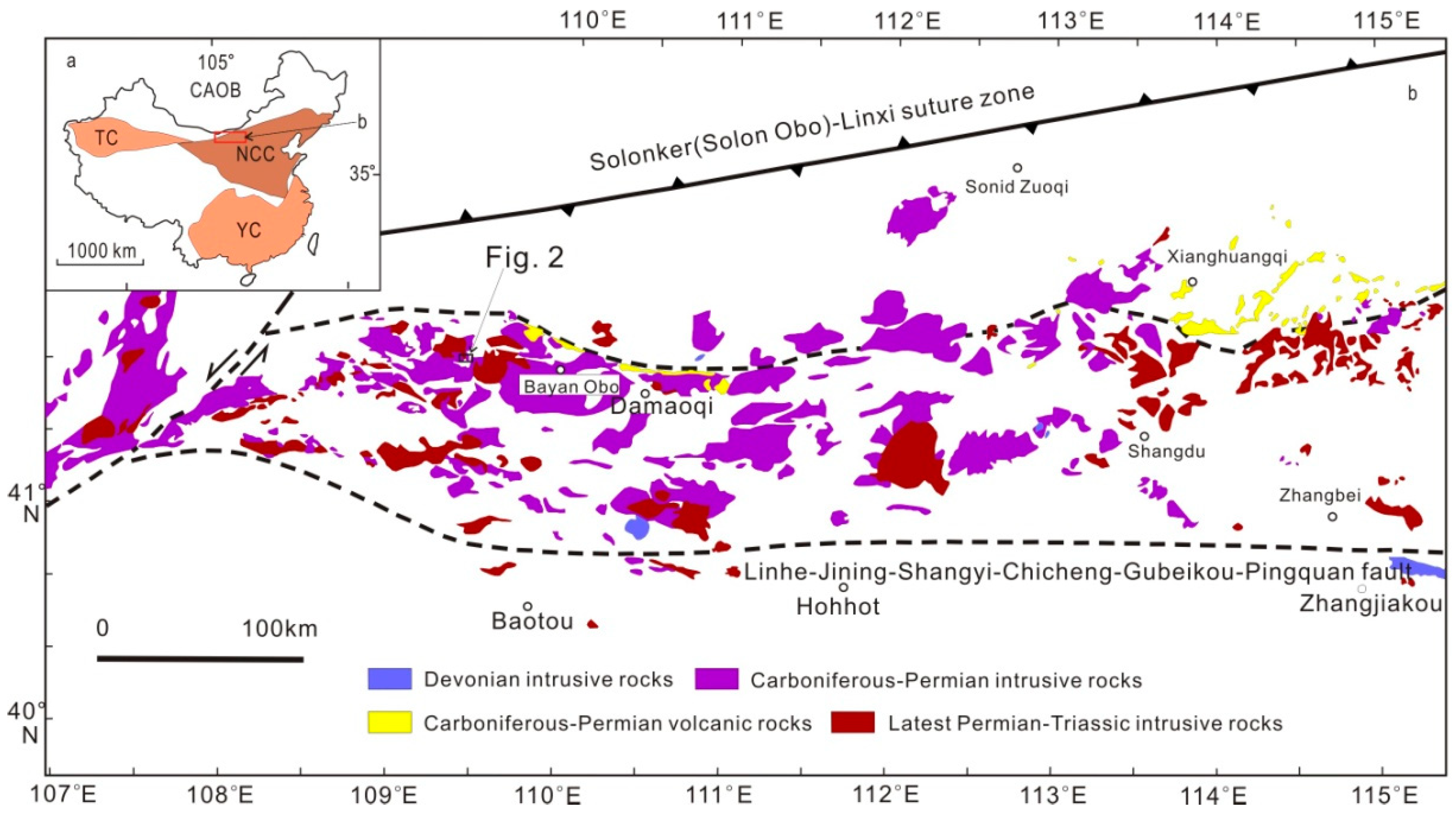
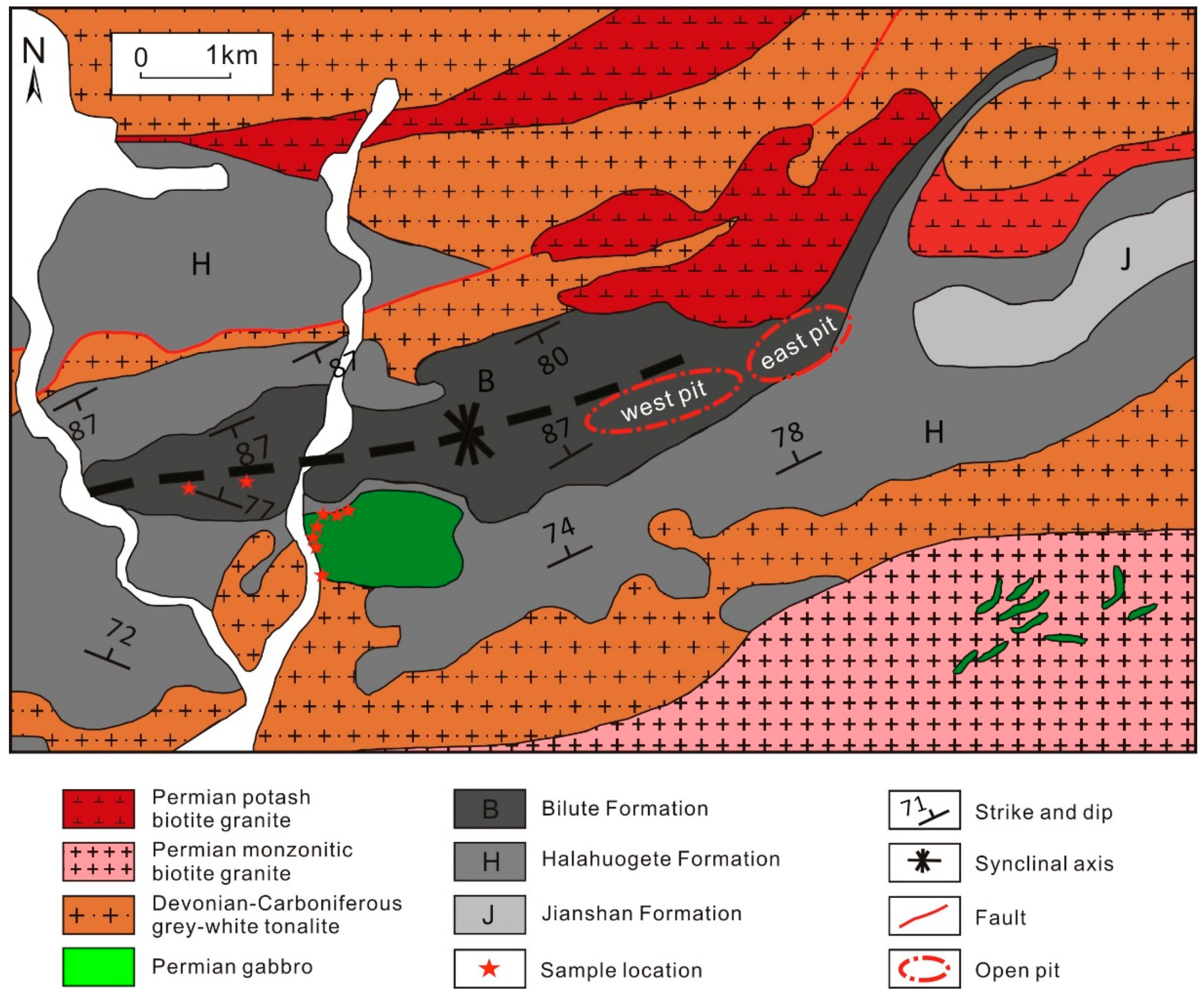
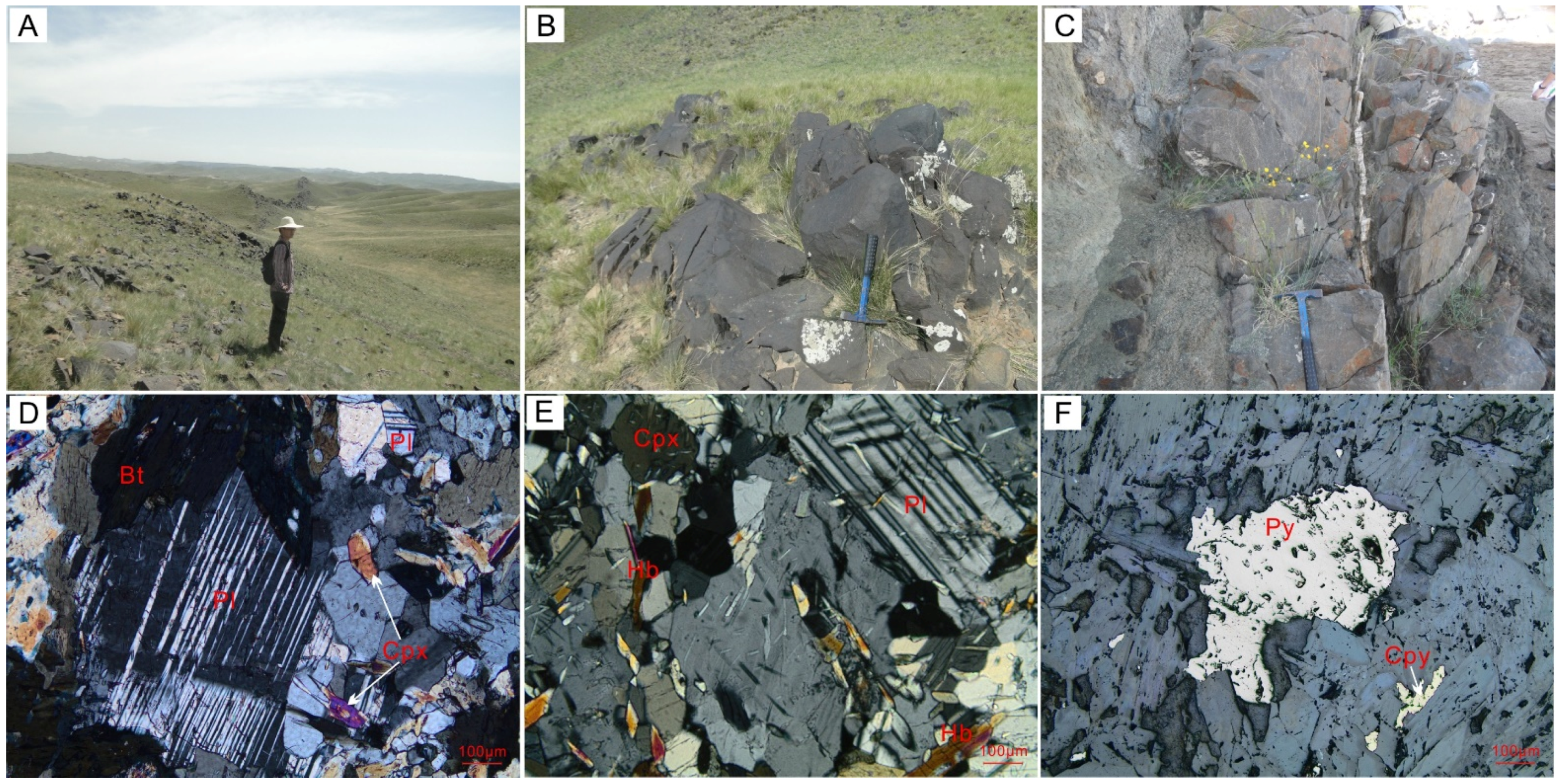
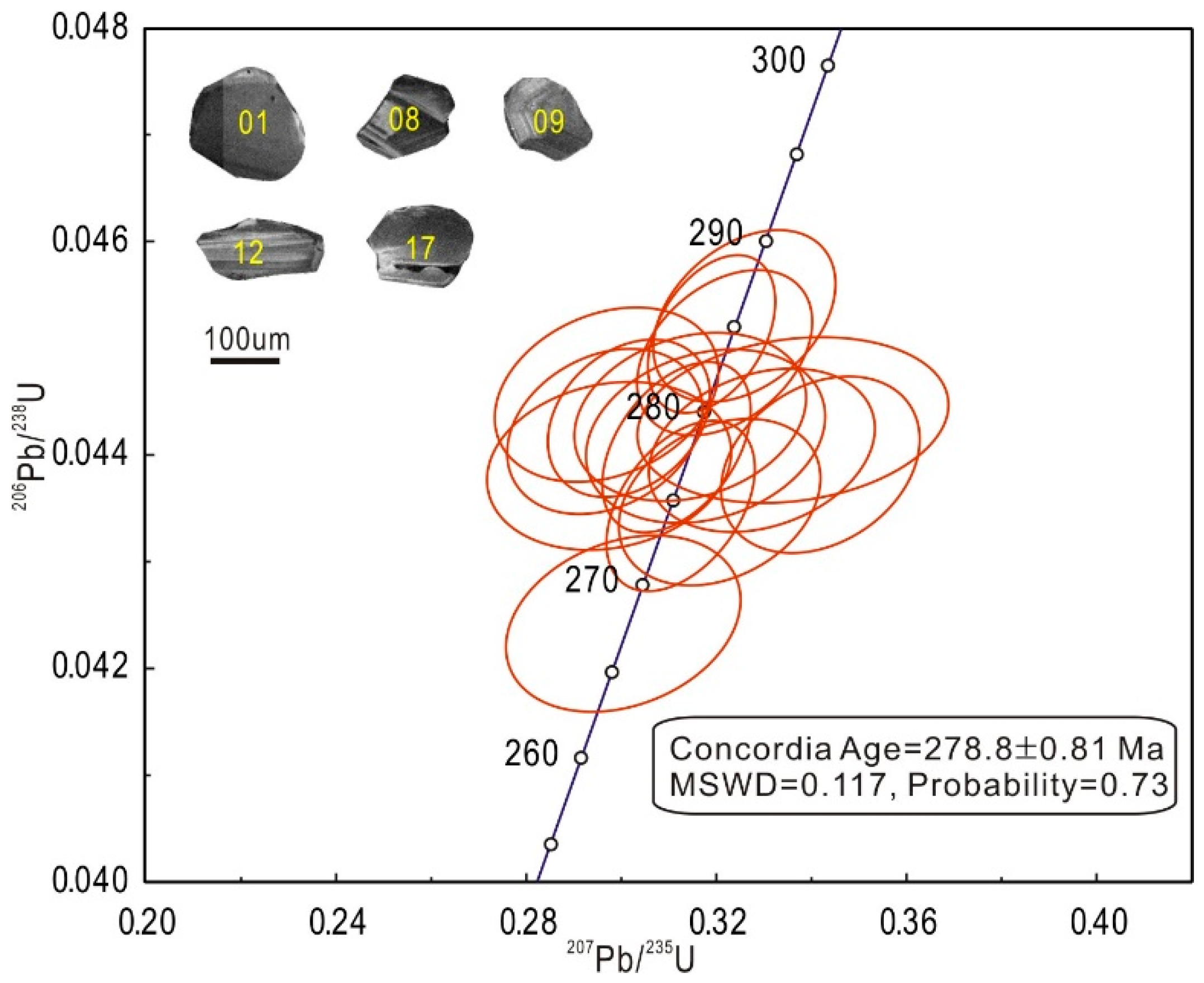
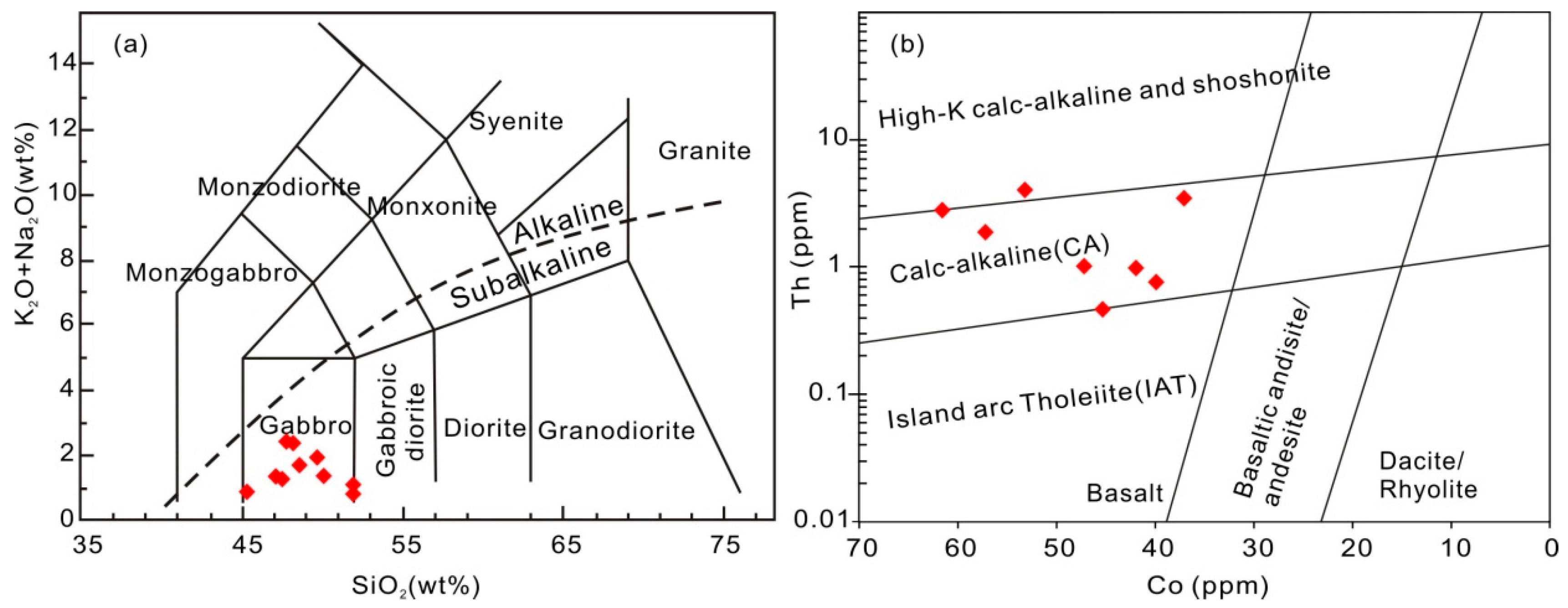
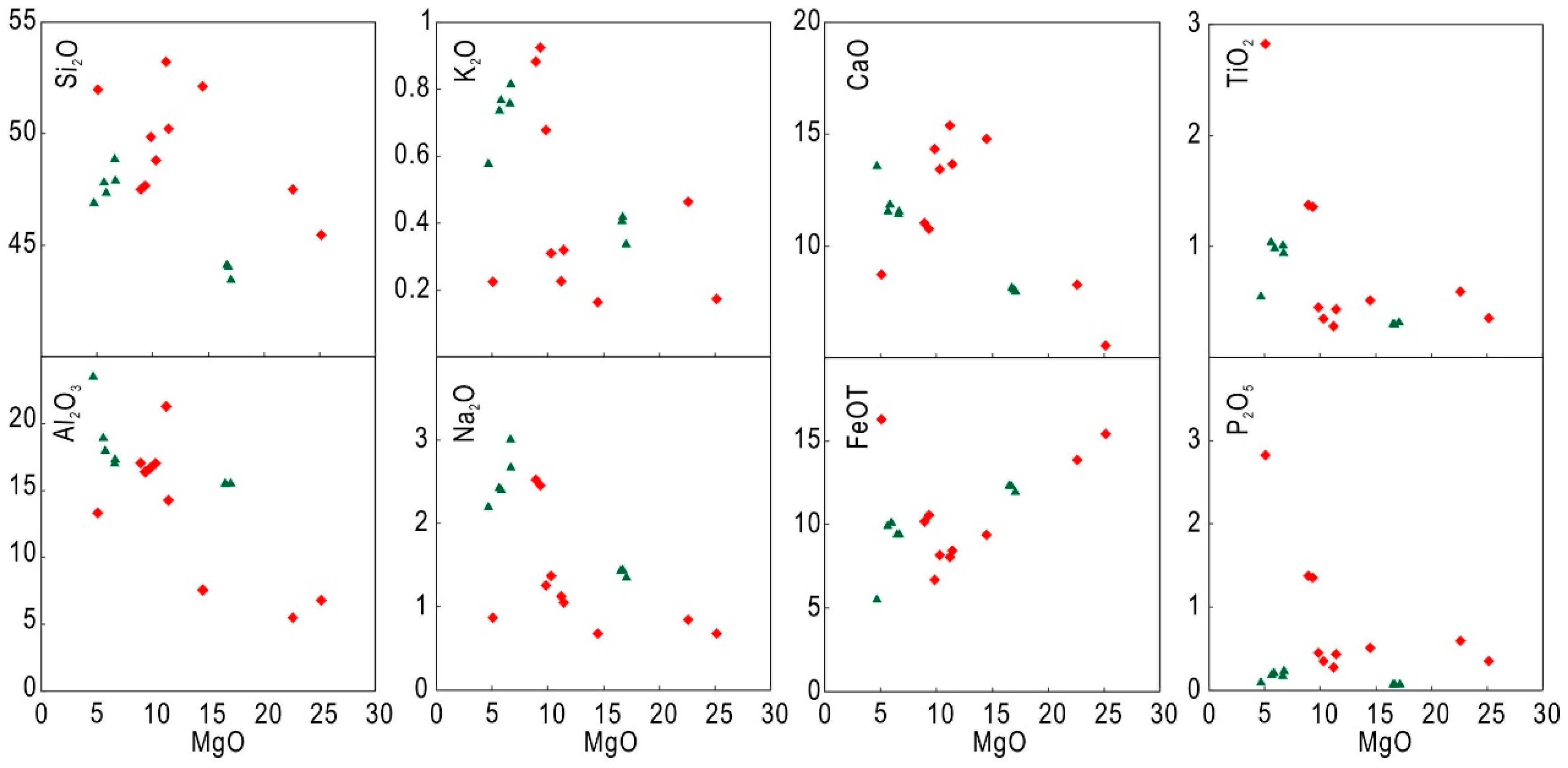

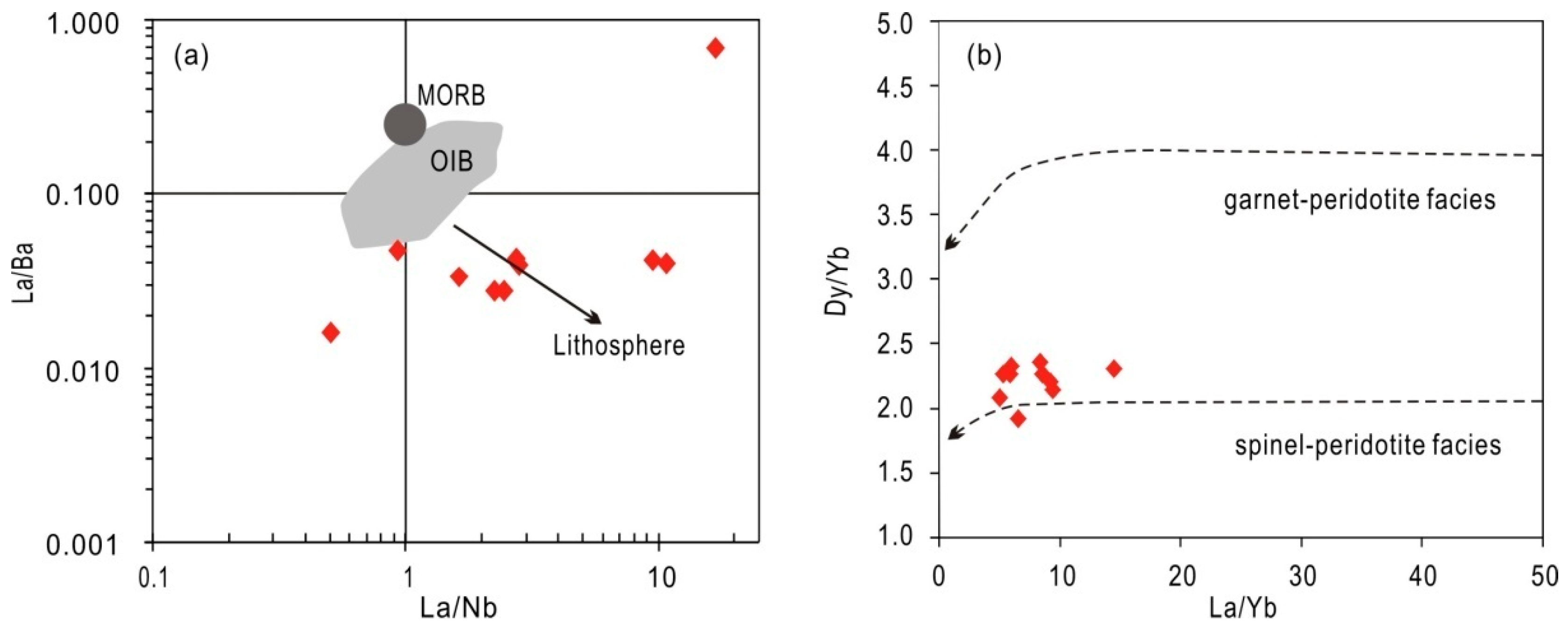
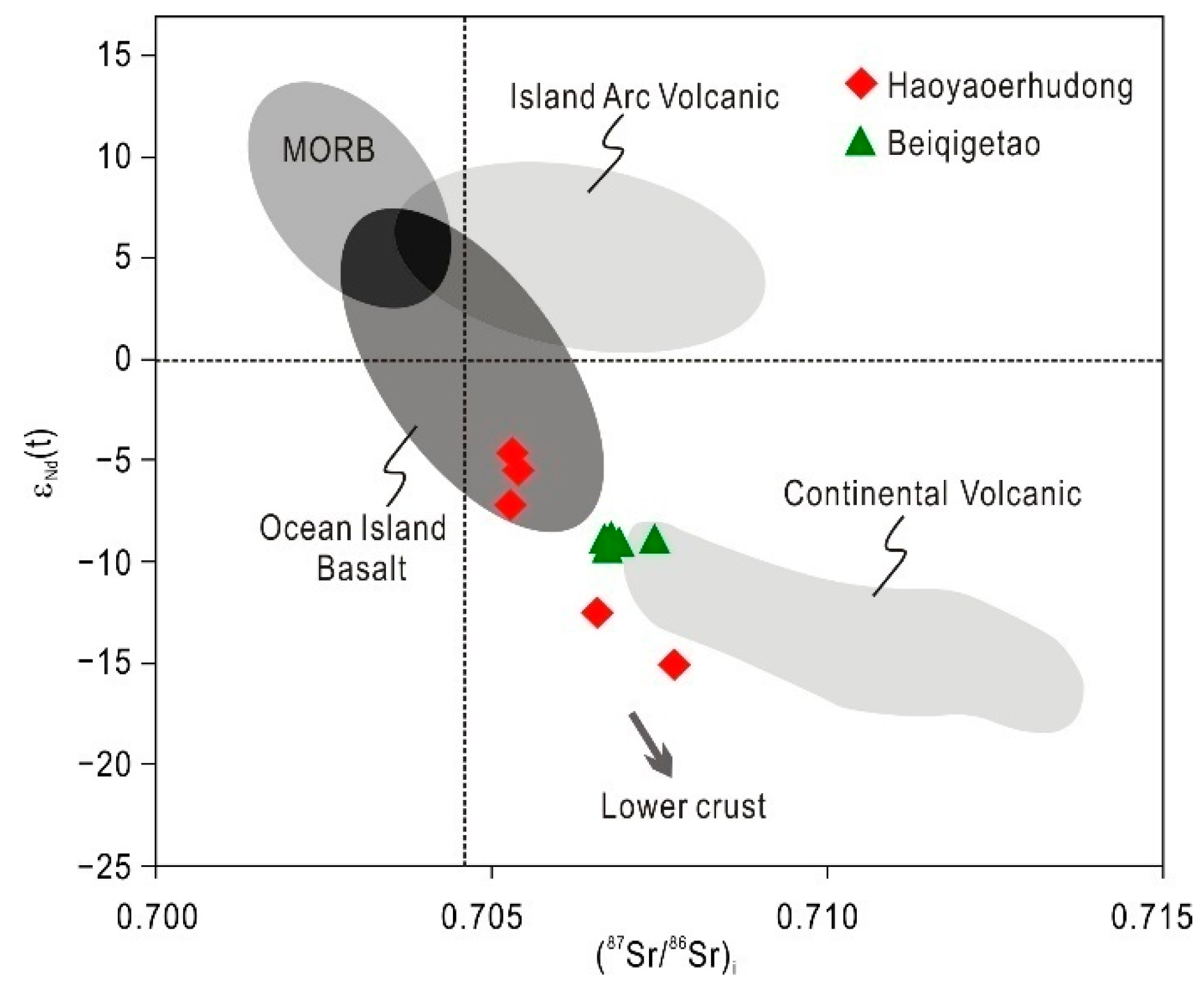
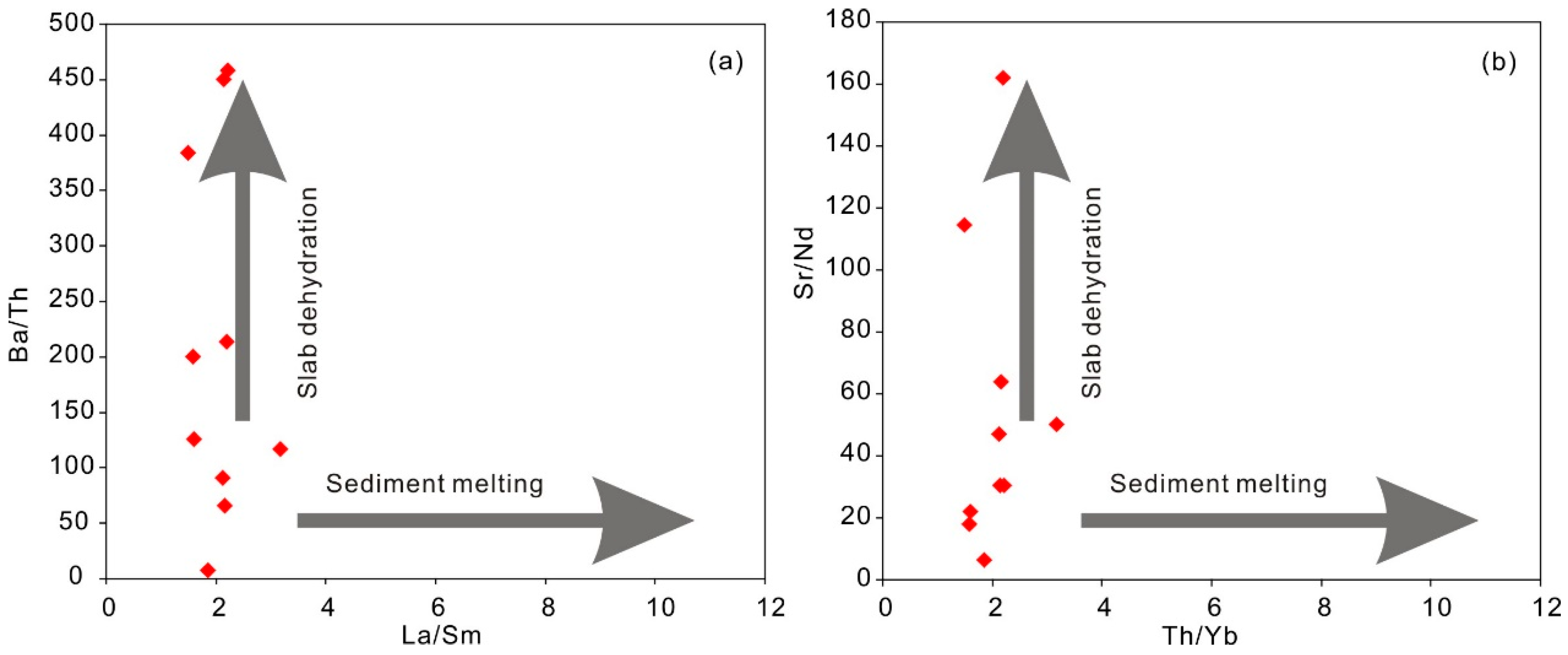
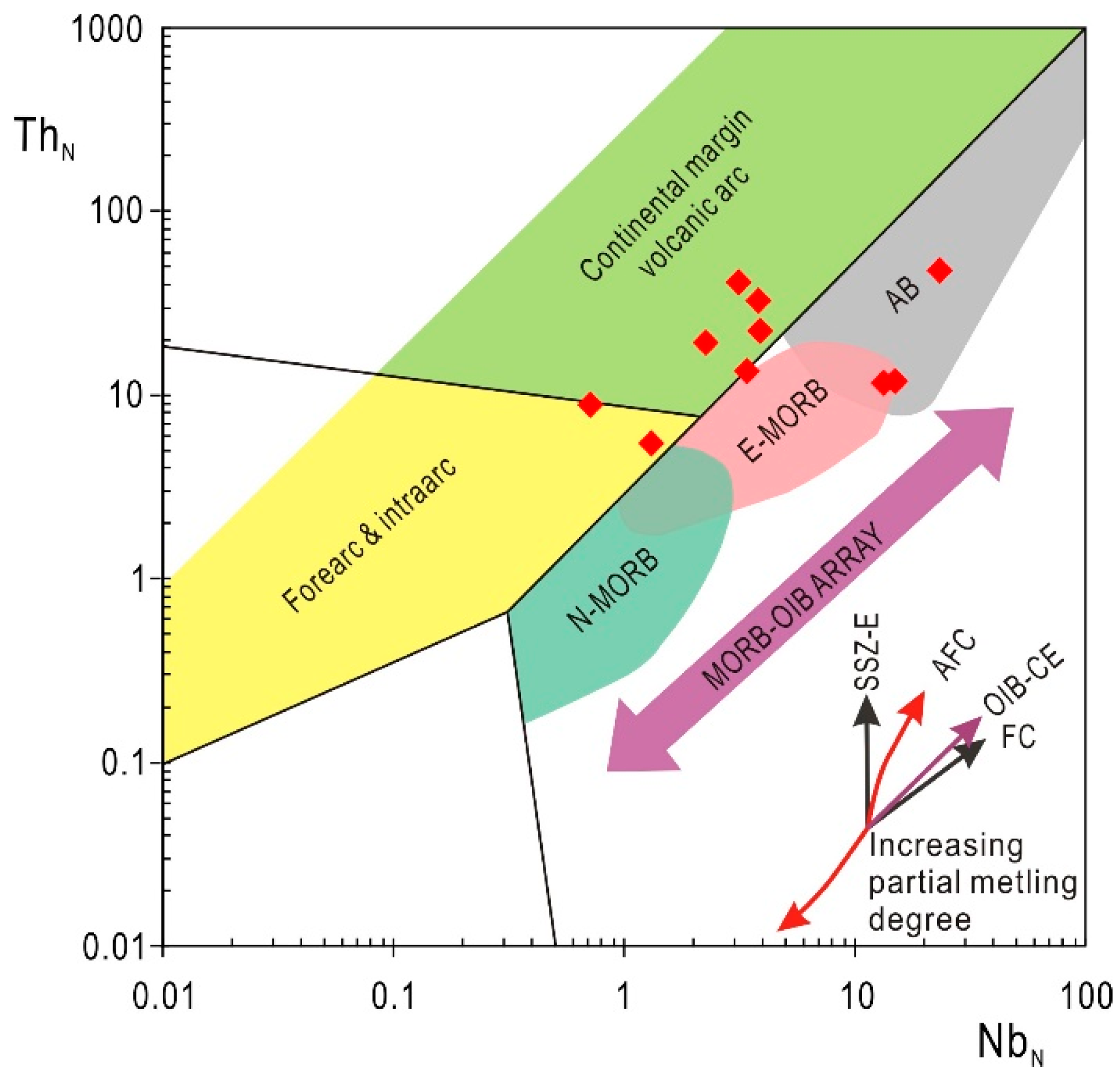
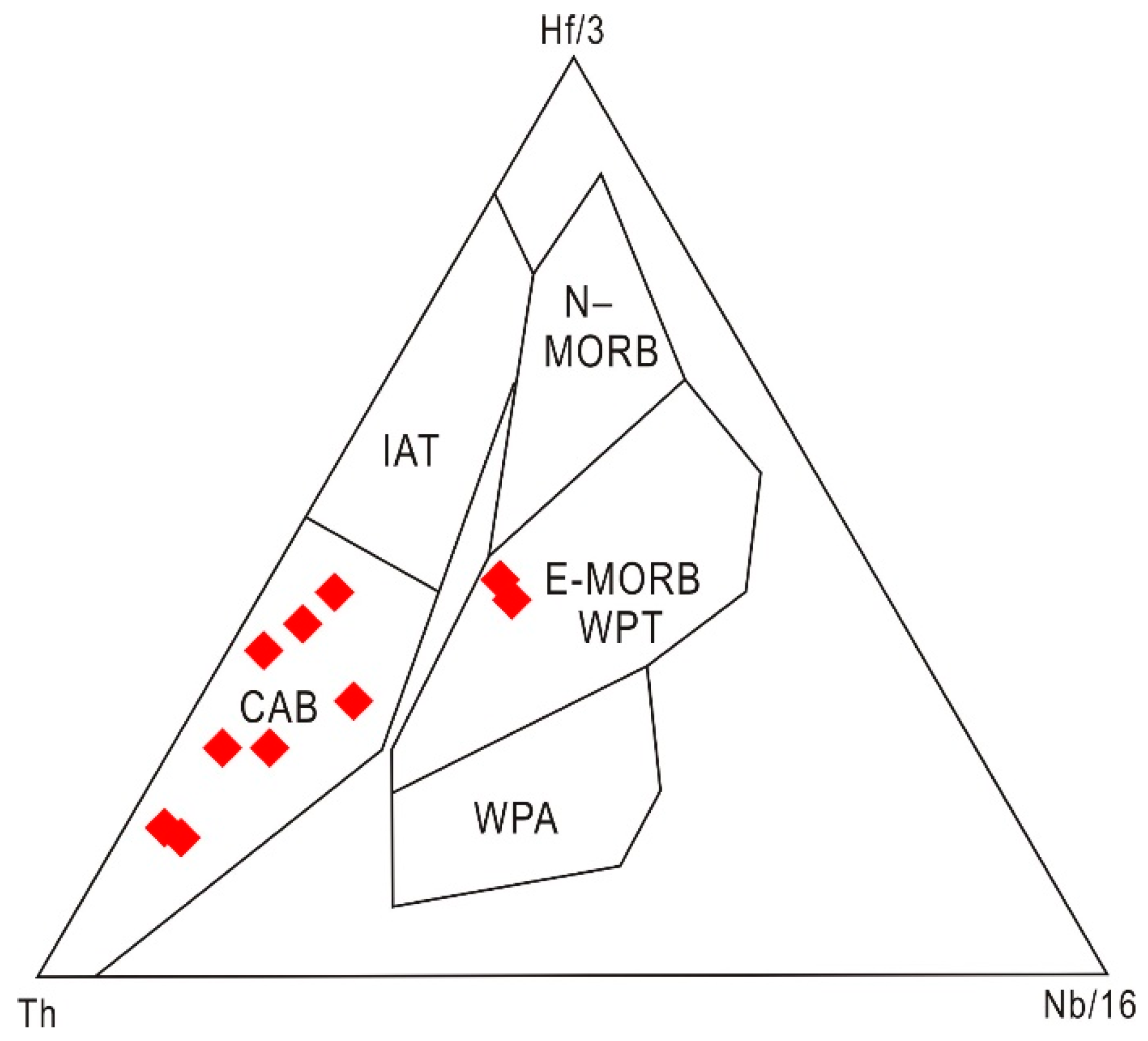
© 2019 by the authors. Licensee MDPI, Basel, Switzerland. This article is an open access article distributed under the terms and conditions of the Creative Commons Attribution (CC BY) license (http://creativecommons.org/licenses/by/4.0/).
Share and Cite
Wang, J.; Wang, X.; Liu, J.; Liu, Z.; Zhai, D.; Wang, Y. Geology, Geochemistry, and Geochronology of Gabbro from the Haoyaoerhudong Gold Deposit, Northern Margin of the North China Craton. Minerals 2019, 9, 63. https://doi.org/10.3390/min9010063
Wang J, Wang X, Liu J, Liu Z, Zhai D, Wang Y. Geology, Geochemistry, and Geochronology of Gabbro from the Haoyaoerhudong Gold Deposit, Northern Margin of the North China Craton. Minerals. 2019; 9(1):63. https://doi.org/10.3390/min9010063
Chicago/Turabian StyleWang, Jianping, Xiu Wang, Jiajun Liu, Zhenjiang Liu, Degao Zhai, and Yinhong Wang. 2019. "Geology, Geochemistry, and Geochronology of Gabbro from the Haoyaoerhudong Gold Deposit, Northern Margin of the North China Craton" Minerals 9, no. 1: 63. https://doi.org/10.3390/min9010063
APA StyleWang, J., Wang, X., Liu, J., Liu, Z., Zhai, D., & Wang, Y. (2019). Geology, Geochemistry, and Geochronology of Gabbro from the Haoyaoerhudong Gold Deposit, Northern Margin of the North China Craton. Minerals, 9(1), 63. https://doi.org/10.3390/min9010063






